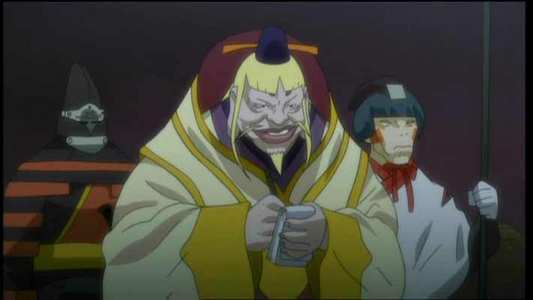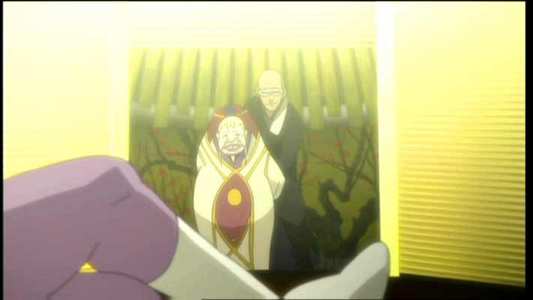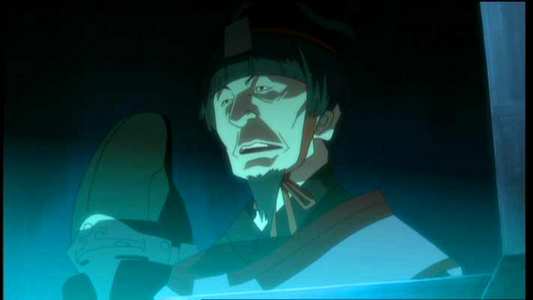Review of Samurai 7: Vol. 5
Introduction
Japan`s anime industry turns to Akira Kurosawa`s classic for inspiration, 50 years after the original Seven Samurai made its debut. With the seal of approval from the estate of Kurosawa, and from the eye candy powerhouse that is Gonzo comes Samurai 7, an animated take on the original story. But this series is set after the second age of the Samurai in the distant future following a devastating war. Once again a village of farmers has had enough of seeing their hard earned produce going into the bellies of giant cyborg bandits, and have decided to recruit warriors of their own to protect their crops. The previous volume saw the battle for the village of Kanna take place, the small band of samurai and their charge of farmers facing up to the overwhelming forces of the Nobuseri. It wasn`t a battle without cost, and as the fifth volume begins, the victors must come to terms with the price they have paid.
In Volume 5: Empire In Flux, Kanbe sets out to keep his promise to Rikichi, and rescue his wife from the capital. While the English episode titles are given on the menu, the translated Japanese ones are quite different, so for convenience, I`ve used both in my review, English first.
17. The Remembrance/Reap!
The battle over, the farmers are finally able to harvest their rice, and the remaining samurai pitch in to help them rebuild their village. Kanbe has left however to deliver on his promise to rescue Rikichi`s wife, and Kyuzo soon follows, intent on settling the outstanding matter between them. Back in Kogakyo city, Ukyo`s machinations step up a gear as he acts to usurp his father`s position as Governor.
18. The Emperor/Go Underground!
To locate the capital, Kanbe turns to the Shikimori for help, but the traders wish to stay neutral. Kanbe will have to trade for the information, and the only capital he has is himself. Which is how he winds up delivered to the Emperor in chains. His plan is thwarted though, when it becomes apparent that Rikichi`s wife Sanae doesn`t want to be rescued. Meanwhile, Katsushiro and Kikuchiyo realise that Kanbe left them behind to safeguard them, and they decide instead to follow him to offer aid. Kirara and Komachi insist on accompanying them though.
19. The Mutiny/Defy!
It took a little longer, but Rikichi finally gets the gumption to go rescue his wife. Which is why Heihachi and Shichiroji had waited before themselves setting out after Kanbe. Meanwhile Kanbe has been sentenced to death for his affront, although he has been given a five-day stay of execution so that the Capital can arrive at Kogakyo, just because Ukyo so desperately wants to watch. Arriving at the Imperial Court, Ukyo is surprised to learn that he is of Imperial descent. Naturally impatient, he decides to hasten the pace of the succession. .
20. The Execution/Change Clothes!
The new Emperor begins by renegotiating a deal with the Nobuseri, while at the same time providing the villages with samurai protection as proved successful in Kanna. There`s more to his contradictory policy than mere capriciousness however. The passing of the previous Emperor also means uncertainty for Sanae and the other kidnapped women. There is the matter of Kanbe`s beheading to be dealt with first, and the Capital arrives at Kogakyo at the same time as Kikuchiyo and Katsushiro.

Video
Samurai 7 gets a colourful and clear anamorphic transfer from MVM on a dual layer disc. As you would expect from a modern anime, it is a stunning mix of traditional 2D and 3D CG animation. The character designs are excellent, and the world design enchants, a future world that is heavily influenced by the past. The animation is exceptional, with the action sequences doing the story justice. Of course there are the usual drawbacks to animation on DVD, the odd compression artefact and the digital banding. But none of it is detrimental to the viewing experience.
However, after the gorgeous eye-candy of the previous volume, the stunning battle sequences at Kanna, the animation takes a hit in the follow up episodes in this volume. Harking back to the odd, minimalist animation of Episode 7, the first two episodes on this disc also suffer from scenes with lower frame counts, less detailed characters and a lack of fluidity. It`s not so obvious in episode 17, which has more than its fair share of flashbacks, but the following episode suffers tremendously in comparison to the rest of the show. We`re back to normal service for the latter half of the disc, but the overall drop in quality means this disc suffers somewhat.

Audio
You get a choice of DD 5.1 English and Japanese, with translated English subtitles or just a signs track. Both audio tracks boast great surround presence. The world design is reflected in the sound design, with the future world a curious mix of hi-tech and steam punk. Samurai 7 has another couple of fine tunes for its credit sequences, but the incidental music is more traditional.

Features
It`s a case of diminishing returns in the extras department. No more character descriptions, and it seems the previous volume`s commentary track was a one off.
You get the textless credit sequences yet again, as well as trailers for Paranoia Agent and Le Portrait de Petite Cossette. And that`s your lot.

Conclusion
After the mid series climax of the previous volume, anything would have been a let down. This fifth volume of Samurai 7 doesn`t do itself any favours by starting off with a flashback episode, and a pretty unimaginative one at that. In fact the first half of the volume seems at a loose end, and meanders for the better part of half an hour trying to build up momentum, difficult after an event that in other series would have been the conclusion. It`s only really the latter half of the disc that once again reels in the viewer and gives some substance to get your teeth into.
The thing is that we are now in uncharted territory. Samurai 7 is based on the Akira Kurosawa film, and that film ended with the battle at the village. For the most part, this series has been a pretty faithful updating of that classic story. There have been moments that have seemed like padding, extra characters and storyline diversions. But those have seemed somewhat extraneous up to now. With this volume, the story continues after the battle, and those previously extraneous plot points come into their own. The whole point of the Ukyo character becomes wholly relevant, the missing wife of Rikichi becomes a motivating factor, and the characters continue to develop.
It`s an interesting move that makes this more than just a simple retelling of the film, and gives the series value in its own right. It also means that those coming to this show from the film can`t expect the same outcome. In essence the show practically starts afresh with this volume, and is essentially at the beginning of a new story. Kanbe decides off-screen to keep his promise to rescue Rikichi`s wife, and the remaining samurai stay behind to come to terms with the previous battle. That`s an excuse for plenty of flashback sequences as we recall all that has happened thus far. It`s a run of the mill first episode that adds little to the story. It`s basically an excuse for weary animators to rest their fingers for an extra week, and avoid RSI. The second episode is where we start layering the meat in the new narrative sandwich, and the world building that has occurred in the background of the first half of the series comes good. A quick flashback to the opening sequence of the show indicates where the Capital came from, and all the intricate relationships between factions that have been developed take centre stage now. It`s also a harsh reminder to Kanbe of the disastrous last war that he took part in.
The introduction to the Emperor is an impressive and alien one. We get to see his gargantuan court, and the Emperor himself is reminiscent of a Navigator from Dune, dwelling in a vast fluid filled tank. Added complexities arise when it becomes apparent that Rikichi`s wife Sanae has fallen for the Emperor and has no desire to leave him. All that is upturned anyway, when Ukyo arrives, and his own Imperial nature is revealed. It also becomes apparent that the capricious, wastrel is merely a mask for a cunning, power-hungry individual, and he`s able to manipulate events with impressive foresight.
The samurai have all split up, but they are all headed in the same direction. Kyuzo`s reasons are simplest of all; he still desires a reckoning with Kanbe to see who the better warrior is. Shichiroji and Heihachi are the most down to earth, and appeared perfectly happy staying in the village to help rebuild. But they knew that Rikichi would set out after his wife, so they remained behind to accompany him. The most interesting character development is that of Katsushiro. Both he and Kikuchiyo were blooded in the previous battle, and the martial life has infected them both. They actually crave more action. That Kanbe left them both behind causes resentment, although in Katsushiro`s case it`s made that more ambivalent given that he also looks up to Kanbe as a teacher. Kirara still feels responsible for what has happened to him, so she also decides to accompany them, and the two keep hovering around what could become a relationship.
After the outstanding volume 4, Samurai 7 seems to stall, and it takes its time finding first gear again. But what seemed like ballast in the earlier volumes actually turns out to be the basis of the second half of the series, and as the story picks up momentum again in this volume, it manages to draw the viewer in, until by the inevitable cliffhanger, we`re hooked once more. I expected Volume 5 to be a comparative disappointment and it was. But the story looks to be heading in an interesting direction for the final two volumes, and given that we are straying beyond the confines of the original film, I`m all the more anticipatory, as I simply don`t know how it will all end.
Your Opinions and Comments
Be the first to post a comment!